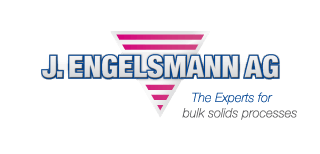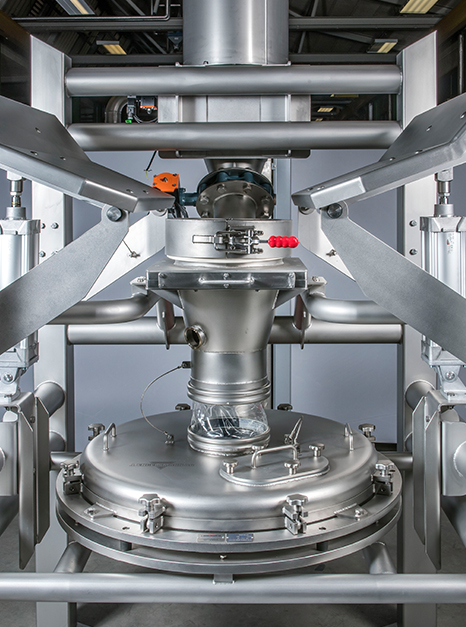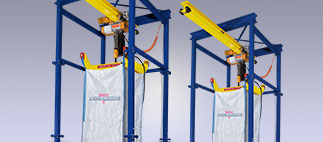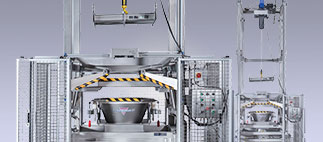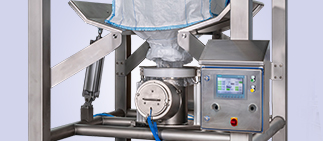Big bag emptying from A to Z
The efficient emptying of big bags is largely dependent on the big bag emptying station used. Here, above all, the actual product characteristics and the operator’s system environment provide the framework for the design of the emptying solution, such as suitable materials and surfaces, the use of emptying aids for challenging products, or integration of peripheral equipment for reproducing downstream processes such as conveying, dosing, screening or mixing, for example.
Depending on the complexity and scope of the task, Engelsmann offers two different different big bag emptying stations: JEL BasicLine and JEL PremiumLine
Big bag emptying stations made by Engelsmann
The JEL BasicLine is predestined for big bag emptying where economic machine use is the highest priority. Thanks to the wide variety of equipment options, this basic variant still offers plenty of freedom for adaptation to various materials and tasks.
» Further information
With the JEL PremiumLine, almost any big bag emptying station, almost any customer requirements can be handled, right up to individually designed, fully automated turnkey solutions (incl. peripherals). For the strictest hygiene requirements, the JEL PremiumLine offers a wide selection of materials and surface treatments.
» Further information
With the JEL SmartCon ES attachment system, big bags can be emptied under containment conditions up to OEB 4. The system is very easy and comfortable to operate.
» Further information
The big bag emptying process itself can be divided into three phases: Transport of the big bag and clamping it into the emptying unit, the actual emptying process and conveying of the product to the corresponding production areas. In addition to the requirement that all big bag emptying work steps are executed quickly and efficiently, important objectives are to protect the operator and the plant environment against dust emissions as well as to reduce material waste during the big bag emptying process to a minimum. As is so often the case with components for the handling of bulk solids, material properties have a specific influence on the design, the functional scope as well as the use of materials for manufacturing emptying units. But also aspects such as the integration of the emptying unit(s) into the plant environment of the operator must be cleanly solved in order that the product is available in the right quantity, with the right characteristics and at the right time exactly where it is processed.
The emptying frame forms the base for all further components including the big bag to be emptied. The feed zone of the unit is positioned in the upper part of the frame, while the actual emptying is carried out in the lower part of the frame. Since big bag emptying stations must sometimes lift extremely heavy big bags, it is important that the frame is built in a stable manner and can be anchored in the floor. The stability of the unit must be guaranteed even under uneven ground conditions – in this case, leveling of the unit is essential. If the big bag emptying unit shall be integrated into an existing production environment, it is favorable if it is adjustable in its dimensions.
In order to feed the emptying unit, there is a loading gear in the upper part of the frame where the big bags are inserted and brought into emptying position. To be able to empty the big bag, you can find an emptying device in the lower part of the frame consisting of emptying unit and discharge hopper. The outlet of the big bag will be clamped into the emptying unit while the discharge hopper positioned underneath serves as collecting vessel for the emptied product which is then forwarded to the next processing step.
 The big bag emptying process is controlled from the operating panel of the plant which is usually located next to the emptying unit. The control should be clearly arranged and allow for an intuitive operation.
The big bag emptying process is controlled from the operating panel of the plant which is usually located next to the emptying unit. The control should be clearly arranged and allow for an intuitive operation.
Last but not least, the plant shall be secured by means of a lockable safety guarding. This often involves circuit breakers which provide for e.g. the emptying process being started only when the door of the safety guarding is closed and the operator is outside the danger zone.
Operators have access to a broad range of additional components for big bag emptying stations to adjust the emptying process even better to the specific task.
Weighing module
An add-on frequently used in practice is a weighing module with which the big bags can be emptied in doses. If an amount of the product smaller than that stored in the big bag is required for the downstream production step, the weighing cell interrupts the material feed into the weighing container, as soon as the correct quantity has been discharged from the big bag.
Spring lift
Spring lifts can be integrated in each unit and ensure that the big bag is tightened during all phases of the emptying process and does not develop any kinks where the product may form deposits.
Closing device
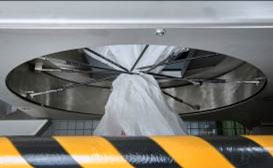 Whenever not the complete content of the big bag is needed, the big bag outlet can be closed by means of a closing device even during full product flow, in order that the partially emptied big bag can be tied up and emptied completely at a later point in time. These closing devices are available in different versions: leaf shutters for example consist of wires arranged in a circle, which are pulled together around the big bag outlet and tightly close it when actuated. These can be actuated either manually or pneumatically. Motorized closing units usually consist of two overlapping sheets in V shape. The drive moves the sheets together until the big bag outlet is tightly clamped in between and the product flow is stopped.
Whenever not the complete content of the big bag is needed, the big bag outlet can be closed by means of a closing device even during full product flow, in order that the partially emptied big bag can be tied up and emptied completely at a later point in time. These closing devices are available in different versions: leaf shutters for example consist of wires arranged in a circle, which are pulled together around the big bag outlet and tightly close it when actuated. These can be actuated either manually or pneumatically. Motorized closing units usually consist of two overlapping sheets in V shape. The drive moves the sheets together until the big bag outlet is tightly clamped in between and the product flow is stopped.
Insertion of the big bag
The big bag emptying process begins with the insertion of the filled big bag into the emptying unit. The operator has different options here.
Integrated crane runway
 For this version, a crane runway is installed into the upper part of the frame, with the loading gear being attached to a chain hoist. Via the integrated control, the operator is able to drive the loading gear out of the unit using the crane runway and lower it above the filled big bag. He must only attach the loops to the hooks of the loading gear – the big bag will be driven automatically into the emptying position at the touch of a button.
For this version, a crane runway is installed into the upper part of the frame, with the loading gear being attached to a chain hoist. Via the integrated control, the operator is able to drive the loading gear out of the unit using the crane runway and lower it above the filled big bag. He must only attach the loops to the hooks of the loading gear – the big bag will be driven automatically into the emptying position at the touch of a button.
Crane runway on site
In this case the big bag emptying station only consists of the lower frame components with the emptying unit and is open upward. During the big bag emptying, the crane runway holds the loading gear and cannot be used otherwise.
Forklift truck
In this version, a forklift truck lifts up the loading gear from the emptying unit and lowers it above the filled big bag. After the loops of the big bag have been attached to the hooks of the loading gear, the operator drives back to the big bag emptying unit and places the loading gear on the frame in the emptying position until it latches and is firmly attached to the emptying unit.
Big bag connection and emptying process
 As soon as the big bag is in its final position, the outlet can be connected with the emptying unit. To this end, the big bag outlet is simply inserted into the emptying unit (or put over it) by hand.
As soon as the big bag is in its final position, the outlet can be connected with the emptying unit. To this end, the big bag outlet is simply inserted into the emptying unit (or put over it) by hand.
Depending on the version of the emptying unit, the closing mechanism can be actuated manually or pneumatically. Since big bags can have discharge nozzles of various lengths, Engelsmann offers “Jel SafeConnect”, a simple solution for the connection of big bags of different sizes, without the need for converting the connection system of the emptying unit.
>> more information JEL SafeConnect big bag attachement system
Material feed to the production process
To discharge the material, different conveying and dosing elements such as screw conveyors or rotary feeders can be installed on the outlet container of the big bag emptying unit. A protective screen is often installed between the emptying container and conveying and/or dosing element in order to separate possible foreign matter from the product before the material gets from the big bag into production.
Specifically in continuous production processes, for which a constant material supply must be ensured, it is recommended to install a filling level indicator in the emptying container which constantly monitors the material filling and signals the need for more material.
The materials to be discharged and their specific characteristics shall be in the focus of the considerations when designing an emptying unit. Whether there are easily flowing or viscous, bridge-forming or dusty bulk solids: the emptying process has to be carried out quickly, continuously and safely for the operator. The big bag throughput per hour required by the client shall be the performance standard here. In order to achieve the desired throughput even with disadvantageous product properties, Engelsmann offers additional equipment in the form of flow media which provide for a fast big bag emptying even with difficult products.
Compacting bulk solids
 If bulk solids tend to compact and are transported or stored for a long time, they form agglomerates or, in extreme cases, are compressed to a “monoblock”. In order to dissolve the agglomerates, Engelsmann offers bumpers, beam pressure and flexing devices. Bumpers and beam pressure devices are mounted to the intermediate supports of the frame and have a lateral effect on the big bag. The bumper consists of pneumatically actuated pressure heads which have the form of a mushroom. During the big bag emptying process, they are pressed against the big bag from both sides to destroy lumps and restore the flow properties of the product.
If bulk solids tend to compact and are transported or stored for a long time, they form agglomerates or, in extreme cases, are compressed to a “monoblock”. In order to dissolve the agglomerates, Engelsmann offers bumpers, beam pressure and flexing devices. Bumpers and beam pressure devices are mounted to the intermediate supports of the frame and have a lateral effect on the big bag. The bumper consists of pneumatically actuated pressure heads which have the form of a mushroom. During the big bag emptying process, they are pressed against the big bag from both sides to destroy lumps and restore the flow properties of the product.
The beam pressure device works based on the same principle. Thanks to the beam shape, this emptying aid has a larger surface and is therefore suited for very hard and extensive lumps. Flexing devices consist of two support cheeks holding the big bag. During the emptying process, they move up and down alternately and lift one side of the big bag respectively. This improves the dumping angle so that viscous products fall into the discharge hopper.
Caking bulk solids
These products tend to form deposits on the inside of the big bag. In extreme cases, the deposits on the inside can build up to such an extent that a narrow tunnel is formed inside the big bag through which significantly fewer product will be discharged from the big bag. The product caked inside the big bag can be loosened mechanically as well by using bumpers, beam pressure and flexing devices have proven to be successful also in these cases. Also vibrating tables provide excellent results when handling caked products. They consist of a hoof-shaped plate which supports the entire bottom of the big bag, The plate is caused to vibrate by means of a vibrating motor. These vibrations are transferred to the entire big bag and dissolve caking which can then be discharged.
Dusting bulk solids
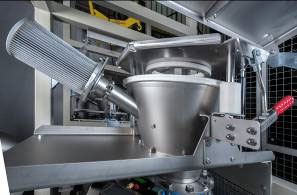 In order to protect both man and machine from explosive atmospheres and dust pollution, it must be ensured that the particularly critical plant parts such as the emptying device, the collecting vessel and the product inlet to the assembled conveying and dosing elements are protected against dust emissions. Ideally, the emptying areas of the units are constructed as completely closed systems. Generally, providers offer the option to connect the big bag emptying unit to an external dedusting system – which extracts and filters the dust from the emptying device – via an aspiration nozzle on the discharge hopper. If the operator does not dispose of an internal dedusting system, most emptying units do also offer the option to install a suction filter directly on the discharge hopper.
In order to protect both man and machine from explosive atmospheres and dust pollution, it must be ensured that the particularly critical plant parts such as the emptying device, the collecting vessel and the product inlet to the assembled conveying and dosing elements are protected against dust emissions. Ideally, the emptying areas of the units are constructed as completely closed systems. Generally, providers offer the option to connect the big bag emptying unit to an external dedusting system – which extracts and filters the dust from the emptying device – via an aspiration nozzle on the discharge hopper. If the operator does not dispose of an internal dedusting system, most emptying units do also offer the option to install a suction filter directly on the discharge hopper.
Generally, plant parts in which dusty materials are processed are ATEX-classified protection zones, i.e. only production equipment with special safety features may be used here to prevent that clouds of dust unintentionally explode due to e.g. flying sparks or heat. When using big bag emptying stations, it is absolutely necessary to ensure that the respective components are certified for the use in an ATEX-classified environment.
Another influence factor for the design of an big bag emptying unit are the industry-specific safety and hygiene directives, as these affect the materials and surface treatments used. In the chemical industry it is often sufficient to use standard steel for the big bag emptying station and stainless steel only for the components coming into contact with the product. In the strictly regulated food and pharmaceutical industries on the other hand, it is usually required to use brushed stainless steel with ground welded seams even for the frame to comply with the high hygiene standards.
Top priority in applications with food and medical products is to prevent product contaminations due to e.g. germ formation or pollution by other products. It must be therefore possible to clean the production equipment in an absolutely residue-free manner. Operators of big bag emptying units shall therefore ensure that especially components coming into contact with the product are constructed free of dead space and that surfaces are as smooth as possible and do not have any cracks or kinks where product residues may form deposits and deteriorate the product. Furthermore, it shall be ensured that all seals of the emptying device are manufactured from correspondingly compliant materials. The suppliers of big bag emptying solutions must provide the respective evidence here. Further information regarding suitable materials can be found in the FDA and GMP guidelines as well as in the EU regulation 1935/EC/2004.

